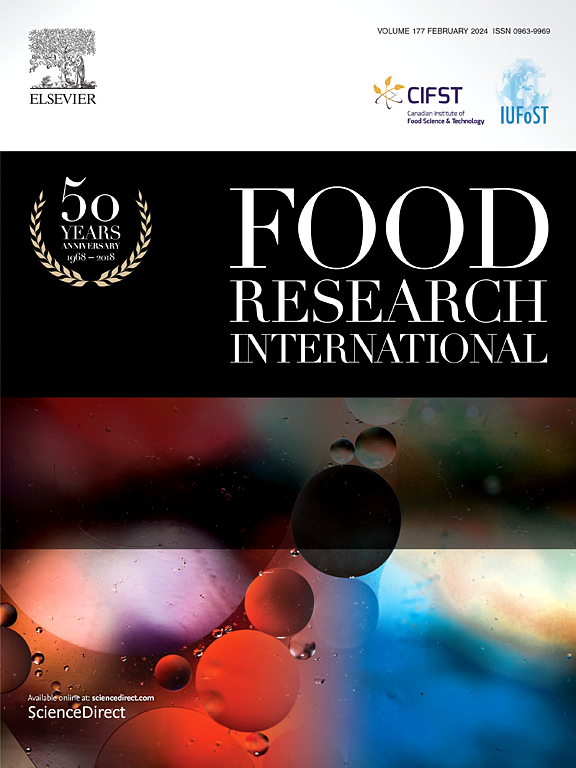Δ-Decanolactone targets PLIN2 and FABP3 in goat milk: Longitudinal multi-omics framework unravels structural destabilization and metabolic reprogramming from flavor fraud
IF 7
1区 农林科学
Q1 FOOD SCIENCE & TECHNOLOGY
引用次数: 0
Abstract
Goat milk is prized for its nutritional value, but the illegal addition of δ-decanolactone to enhance flavor poses risks to product integrity and safety. This study employed a tripartite multi-omics framework integrating metabolomics, lipidomics, and proteomics, combined with FTIR and CLSM to systematically elucidate the multifaceted effects of δ-decanolactone on goat milk. Chemometric and bioinformatic pipelines identified dysregulated molecules and pathways, while molecular docking validated interactions with key targets. δ-Decanolactone modifies the secondary structure of proteins, reducing α-helix by 18.3 % and increasing β-sheet by 38.1 %, while concurrently disrupting the integrity of milk fat globule membrane, compromising the emulsifying and functional properties. Multi-omics profiling revealed around 166 metabolites, 378 lipids, and 41 proteins were dysregulated at the high δ-decanolactone exposure. Joint analysis highlights that δ-decanolactone perturbs in amino acid-fatty acid-phospholipid axis via down-regulating PLIN2, FABP3, and LPL levels, and up-regulating B4GALT1 and XDH levels. Molecular docking confirmed stable interactions between δ-decanolactone and key enzymes, linking the observed structural and functional impairments. These findings establish δ-decanolactone as a multifunctional disruptor of goat milk matrix integrity, driving metabolic rewiring and structural collapse. The identified biomarkers provide actionable tools for adulteration monitoring, supporting stricter regulatory policies and optimized dairy processing to safeguard nutritional quality and consumer safety.

Δ-Decanolactone靶向羊奶中的PLIN2和FABP3:纵向多组学框架揭示了风味欺诈导致的结构不稳定和代谢重编程
羊奶因其营养价值而受到重视,但为了增强风味而非法添加δ-癸酸内酯给产品的完整性和安全性带来了风险。本研究采用代谢组学、脂质组学和蛋白质组学相结合的三重多组学框架,结合FTIR和CLSM,系统地阐明了δ-十醇内酯对羊奶的多方面影响。化学计量学和生物信息学管道确定了失调的分子和途径,而分子对接验证了与关键靶点的相互作用。δ-癸内酯改变了蛋白质的二级结构,α-螺旋减少18.3%,β-片增加38.1%,同时破坏了乳脂球膜的完整性,影响了乳脂球的乳化和功能特性。多组学分析显示,在高δ-十烷内酯暴露下,大约166种代谢物、378种脂质和41种蛋白质出现失调。联合分析发现,δ-十醇内酯通过下调PLIN2、FABP3和LPL水平,上调B4GALT1和XDH水平,扰乱氨基酸-脂肪酸-磷脂轴。分子对接证实了δ-癸内酯与关键酶之间稳定的相互作用,将观察到的结构和功能损伤联系起来。这些发现证实了δ-癸内酯是羊奶基质完整性的多功能干扰物,可驱动代谢重组和结构崩溃。鉴定的生物标志物为掺假监测提供了可行的工具,支持更严格的监管政策和优化乳制品加工,以保障营养质量和消费者安全。
本文章由计算机程序翻译,如有差异,请以英文原文为准。
求助全文
约1分钟内获得全文
求助全文
来源期刊

Food Research International
工程技术-食品科技
CiteScore
12.50
自引率
7.40%
发文量
1183
审稿时长
79 days
期刊介绍:
Food Research International serves as a rapid dissemination platform for significant and impactful research in food science, technology, engineering, and nutrition. The journal focuses on publishing novel, high-quality, and high-impact review papers, original research papers, and letters to the editors across various disciplines in the science and technology of food. Additionally, it follows a policy of publishing special issues on topical and emergent subjects in food research or related areas. Selected, peer-reviewed papers from scientific meetings, workshops, and conferences on the science, technology, and engineering of foods are also featured in special issues.
 求助内容:
求助内容: 应助结果提醒方式:
应助结果提醒方式:


